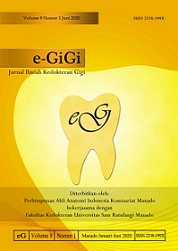Gambaran Temporomandibular Disorder pada Lanjut Usia melalui Fonseca’s Questionnaire
Abstract
Abstract: Decrease of stomatognathic organ function could result in decrease of quality of life (QoL) in geriatric patients. Temporomandibular disorder (TMD) creates a limitation in mouth opening, crepitation, and headache. This study was aimed to obtain the signs and symptoms of TMD through Fonseca’s Questionnaire in Semarang nursing home for elderly. This was a descriptive and observational study with a cross sectional design. Fonseca’s questionnaire and other questionnaires about medical history as well as dental and oral treatment history were used in this study. Fonseca anamnestic index was used to classify the TMD severity based on the total score of the answers. The chi-square was used to determine the differences between variables related to the TMD severity. The results obtained 57 respondents who were grouped based on age, sex, medical history, and dental and oral treatment history. There were 17 respondents without TMD, 18 had mild TMD, 12 had moderate TMD, and 10 had severe TMD. Besides age, emotional stress and tooth extraction were the most common causes and had significant effect on TMD severity (p<0.05). In conclusion, TMD severity will increase along with age, meanwhile, optimal dental and medical care can help to reduce the TMD severity in geriatric patients.
Keywords: elderly, temporomandibular disorder, Fonseca's questionnaire
Abstrak: Penurunan fungsi stomatognatik dapat menyebabkan penurunan kualitas hidup pada lansia. Penurunan fungsi tersebut pada temporomandibular disease (TMD) menyebabkan terjadinya keterbatasan dalam membuka mulut, krepitasi pada saat membuka atau menutup mulut, dan sakit kepala. Penelitian ini bertujuan untuk mendapatkan gambaran deteksi tanda dan gejala TMD melalui Fonseca’s Questionnaire di panti wreda Kota Semarang. Jenis penelitian ialah deskriptif observasional dengan desain potong lintang menggunakan Fonseca’s questionnaire serta kuesioner tentang riwayat medis, dan riwayat perawatan gigi dan mulut. Fonseca anamnestic index digunakan untuk menglasifikasikan tingkat keparahan TMD berdasarkan total skor jawaban kuesioner. Uji chi-square digunakan untuk mengetahui perbedaan antara variabel dengan tingkat keparahan TMD. Hasil penelitian mendapatkan 57 responden yang dikelompokkan berdasarkan usia, jenis kelamin, serta riwayat medis dan riwayat perawatan gigi dan mulut. Terdapat 17 responden tanpa TMD, 18 dengan TMD ringan, 12 dengan TMD sedang, dan 10 dengan TMD berat. Stres emosional dan pencabutan gigi merupakan penyebab tersering serta memiliki perbedaan bermakna pada tingkat keparahan TMD disamping usia (p<0,05). Simpulan penelitian ini ialah tingkat keparahan TMD akan meningkat seiring bertambahnya usia, namun perawatan medis serta gigi, dan mulut yang optimal dapat mengurangi keparahan TMD pada lansia.
Kata kunci: lanjut usia (lansia), temporomandibular disorder (TMD), Fonseca’s questionnaireFull Text:
PDFDOI: https://doi.org/10.35790/eg.9.1.2021.32633
Refbacks
- There are currently no refbacks.

